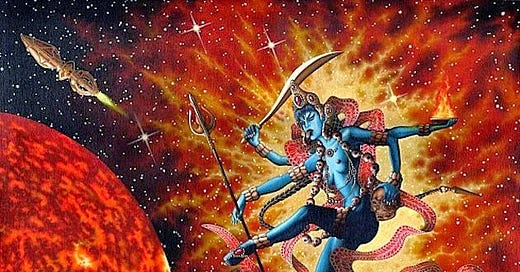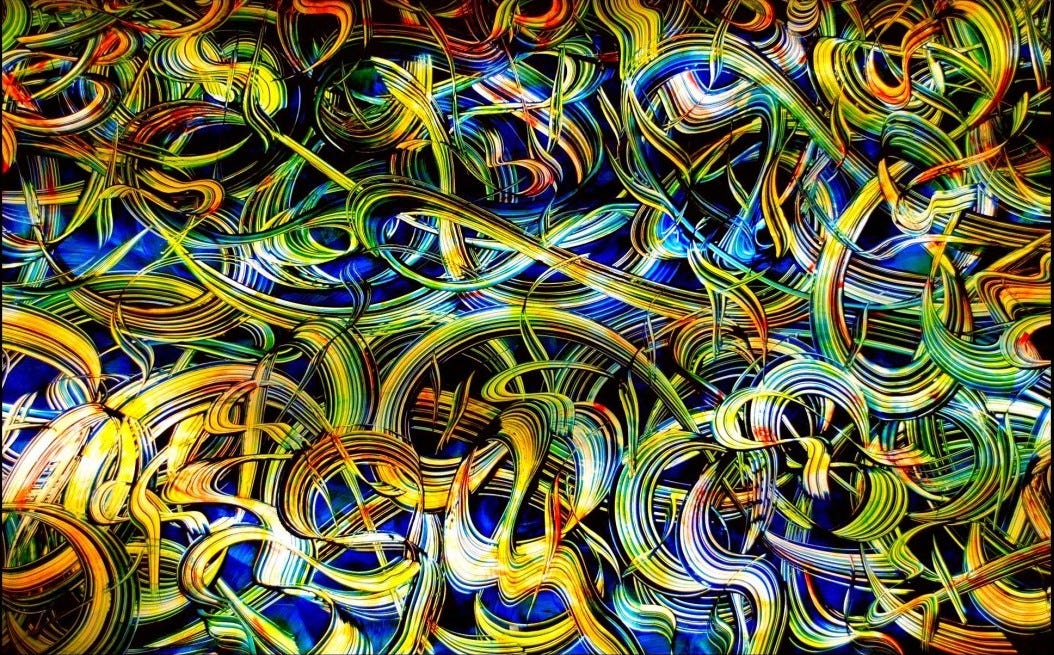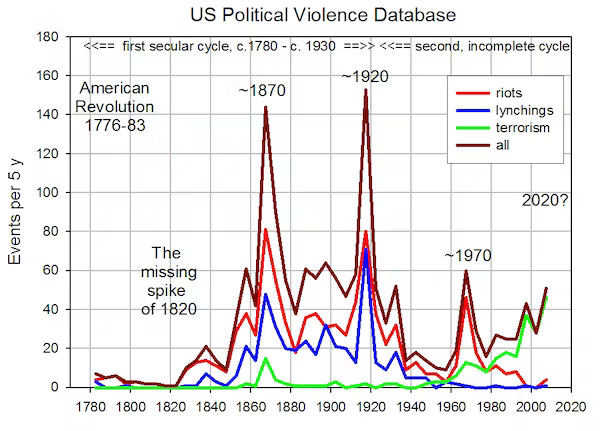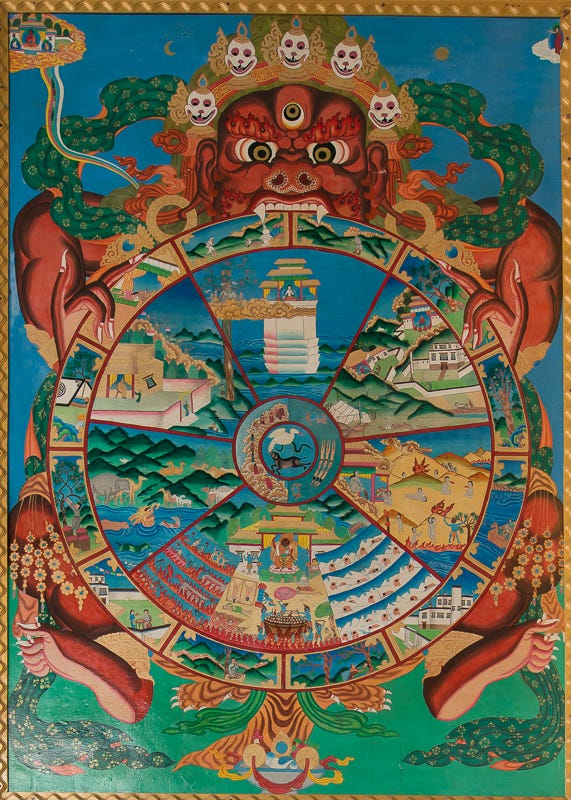In the Age of Kali Yuga, spirituality and morality are diminished to shadows of their former selves. Deception and hypocrisy in the name of religion is the status quo.
Popular Vedic Science
It is estimated the Kali Yuga period began some 5,000 years ago and is predicted to end in 2025, to be followed by a centuries-long transition that leads to the Satya Yuga, a new Golden Age.
According to various interpretations of the Hindu scriptures and cosmological texts, the approaching end of the Kali Yuga is often associated with a time of increased fear, apprehension, and societal unrest driven by uncertainty and chaos, which characterize the dark age of Kali Yuga.
While excessive or chronic fear can be debilitating, moderate and temporary fear can play a positive and protective role. For example, fear can heighten our senses and increase alertness, thereby improving focus and responsiveness. Fear helps individuals assess risk by nudging them to consider potential negative outcomes. I believe the time is nigh to assess such risks. While some of these risks are existential, forewarned is forearmed.
Trials and tribulations, such as those we endure in this transient age of darkness, ultimately become drivers of evolution in spiritual awareness and human consciousness. At its core, this truism affirms that hardships are not merely inconvenient obstacles to happiness but are transformative experiences that prompt introspection and growth.
Just as physical stressors can strengthen the body, mental and emotional challenges can foster resilience and wisdom. Trials serve as catalysts for spiritual development, encouraging individuals to question, learn, and evolve. The navigation of tribulations can lead to a deeper understanding of the self, life, and one's place in the world. Trials and tribulations often produce what the Greeks called metanoia, a transformative change of heart and a new worldview.
In the ordeals of hardship, individuals often confront their fears, insecurities and attachments. This confrontation can shatter previously held illusions, paving the way for new perspectives and higher levels of consciousness. The process, though difficult, can be a vehicle for shedding old, limiting beliefs and awakening to one's inherent potential and destiny.
Suffering and hardship often cultivate empathy and compassion, the foundational elements of spiritual evolution. Experiencing personal pain can expand our capacity to connect with the suffering of others, thereby fostering unity and interconnectedness, principles endemic to most spiritual traditions.
Challenges confronted by societies and civilizations lead to cultural, moral, and spiritual shifts that redefine shared values and collective identities, or refortify existing ones that remain viable.
Our present challenges are characterized by the dwindling of goodness and the inversion of virtue; the rise of authoritarianism; technological disruptions, notably transhumanism and artificial intelligence; the feminization of Western societies;1 spiritual degeneration; and other ineluctable trends such as political turbulence, which often presage the collapse of civilizations.
Worse yet, the Kali Yuga cycle, expected to conclude around 2025, roughly coincides with a slew of other (at least six) recently concluded or soon-to-conclude historical cycles, including the Mayan Calendar’s Great Cycle, the Fourth Turning, Arnold Toynbee’s 'Time of Troubles,' and Oswald Spengler’s 'Winter Season.' The latter two, according to their authors, portend the final chapter in the history of Western Civilization.
Most geopolitical experts agree that we are transitioning from a unipolar world to a multipolar or multinodal world. The current hegemon, the U.S., or what some call the Anglo-Zionist Empire, is resisting this development mightily.
On the cyclical economic front, the Kondratieff Cycle, devised by Nikolai Kondratieff in 1925, is also concluding its 'Winter' season.2
The economy [is] in the throes of a debilitating depression that tears the social fabric of society, as the gulf between the dwindling number of “haves” and the expanding number of “have-nots” increases dramatically.
Nikolai Kondratieff
We should also mention that Earth's Piscean Age, a ~2,000 year precessional cycle associated with Christianity and the Biblical Apocalypse, is transitioning to the Aquarian Age. One could reasonably consider this extraordinary convergence of multiple cycles as proffering a period of punctuated disequilibrium.3
There is always, however, a silver lining to paradigmatic change. Kali is not only a mother goddess but also an avatar of creative destruction in her asura aspect. Kali encompasses both nurturing and fierce attributes, making her a complex and revered figure in Hindu spirituality. In comparative mythology, both Kali and Christ embody dualities. Kali balances creation and destruction, while Christ bridges humanity and divinity.
Philosophers such as the late Teilhard de Chardin envisaged a significant creative leap in human consciousness and universal spiritual awareness, which he (and others) referred to as the Noosphere. Teilhard foresaw an order emerging from chaos, which he called a new 'Radial Energy' — a spiritual energy that, over time, would stratify into higher states of conscious awareness.
When we refer to cycles of history, as opposed to linear timelines of history, we implicate a spiritual dynamism driven by energy akin to Teilhard’s 'radial energy.' This spiritual component, essential to humanity’s evolution, may explain why Newtonian physicalists, for whom the endless march of time is reducible to a sequential, linear process of cause-and-effect deterministic events, tend to eschew, even ridicule, cyclic interpretations of time.
However, the evidence of historical cycles is clearly there for those with eyes to see.
Spiritually balanced individuals practice temperance, the noble act of modulating one’s thoughts, actions, and emotions. Irrational and biased perspectives fraught with ignorance or irrationality beget fear, stress, and anxiety, which are prime drivers of authoritarian control over society. This is sorely evident.
The ancient Greeks, to whom we often look for ageless wisdom, framed history using three distinct concepts of time.
Aion - In ancient Greek philosophy, aion often refers to an unbounded, infinite duration of time or eternity. It also can represent a complete life cycle, an epoch or an age in the world's existence. In cosmology, Aion has been used to represent the eternal nature of the cosmos. In Greek mythology, Aion is typically depicted as a young man with wings about his temples.
Chronos - Chronos, often personified in myth as the elderly god of time, represents the chronological or sequential aspect of time. It is quantifiable and measurable, similar to how most understand and use time today - hours, minutes and seconds. It's about clock time, calendar time and the objective passage of moments.
Kairos - Kairos refers to an opportune moment or the right time for action. It is less about chronological time and more about the qualitative aspect of time. Kairos is about recognizing the significance of a particular moment and then acting at the right time. It's more subjective and situational compared to Chronos. Kairos was also known as “God’s time.”
Viewing time through the wide-angle lens of Kairos helps to modulate fear and anxiety. Taking the 'big picture' into account demonstrates spiritual and emotional maturity, not to mention much greater self-awareness.
If Chronos symbolizes the quantity of time, then Kairos represents its quality. In my view, if we paid more attention to Kairos and less to Chronos, the world would be a better, safer place. The materialistic commoditization of Chronos gives us facile sayings like, 'Time waits for no one,' 'Time is money,' and 'Time’s a-wastin.’
Regarding the West’s precipitous slide into authoritarianism, a question I repeatedly see asked here on Substack is: 'What can we do to halt, slow, or reverse this process, which is antithetical to democratic principles and values?”
We could begin by spending more of our time in Kairos, learning to trust and cooperate with nature’s processes. All phenomena are impermanent, particularly political systems. That said, we should persist diligently in our mission as Messengers of Truth to the malinformed masses.
We are the Watchers. Translated from Aramaic, this means 'the awake ones.' Let us now assess two existential risks to humanity that some might view as Divine Wrath, and others as Creative Destruction.
The Taurids
One thing is certain: if the World Economic Forum's and United Nations’ 2030 Agenda, driven by malevolent forces, continues as planned, we should expect — and even pray for — divine intervention. The alternative for humanity would be far more dire.
Transhumanists believe human consciousness can be reduced to mere ones and zeros. It cannot. Personal consciousness is sacred, intertwined with the eternal human soul. The godless transhumanist overlooks a crucial truth: consciousness is not an emergent property of the brain. Rather, it is the non-local, omnipresent 'Ground of All Being,' a spiritual insight articulated by theologian Paul Tillich.
He called in a loud voice: ‘Cut down the tree and trim off its branches; strip off its leaves and scatter its fruit. Let the animals flee from under it and the birds from its branches. But let the stump and its roots, bound with iron and bronze, remain in the ground, in the grass of the field.
Daniel 4:14,15
The Taurid meteor stream, an annual cycle that occurs from late September to early December, is named for its apparent proximity to the constellation Taurus — the meteors appear in the direction of that constellation. The Taurid’s debris field is composed of remnants from a prehistoric comet, Comet Encke, which exploded thousands of years ago. My recent post on the Taurid Complex is here.
It is believed that several large fragments from the Encke explosion collided with Earth around 12,800 years ago, an event linked to the destruction of ancient civilizations, including Atlantis and ended the Younger Dryas period.4 We previously explored this in detail in Our Atlantis Moment post.
In a recent Substack by Bari Weiss, historian Peter Turchin foresees our society reaching a “breaking point” in 2024. The piece is titled, “Are we living through End Times?”
What precedes actual violence is violent rhetoric. So 2024 is going to be a really high probability break point. Typically periods of heightened instability take many years, somewhere between 10 and 20 years. So what I hope is that in 2035, the headlines would be that we managed to get the worker wages to grow, and the economy is finally growing in a sustainable way. That’s one possible outcome. The other possible outcome is the previous decade was so horrible, everybody became tired of violence, so nobody wants to start violence again.
A robust middle class is perhaps the greatest deterrence to elitist authoritarian rule. Barron’s newspaper notes America’s middle class faces its greatest threat since the 1930s.5
Turchin adopts a distinct approach to interpreting historical cycles, known as cliodynamics, named after Clio, the Greek Muse of History. Unlike traditional methods that often rely on drawing analogies from past events, Turchin’s approach is scientific, using data-driven analysis. In an era where historical narratives are often skewed or polluted, this more objective approach to cycle theory is both refreshing and necessary.
The adherents of cliodynamics treat the historical record just as evolutionary biologists would treat the palaeontological record. Theories are constructed and based on general principles and tested empirically with comprehensive databases. In short, we use the standard scientific method that worked so well in physics, biology and many social sciences.6
Depopulation
Depopulation has become a controversial and urgent topic on Substack, as recent evidence of genocidal actions is increasingly difficult to dismiss. For further insight, consider the video below featuring Dr.
, as well as the Substack by .In Summary
The concept of cycle theory is as ancient as the philosophy of time itself. The idea that societies, like all natural phenomena, undergo cycles of birth, growth, decline, and rebirth has been contemplated and developed by numerous scholars. Central to this idea is the ancient Greek concept of Kyklos, originally espoused by Plato and Aristotle, and later expanded upon by Polybius through his theory of Anacyclosis.
Plato and Aristotle, the twin titans of Greek philosophy, were among the earliest thinkers to propose a cyclical view of political regimes. Their concept of Kyklos suggested that governments inevitably cycle through distinct stages: from monarchy to tyranny, from aristocracy to oligarchy, and from polity to democracy, which then degenerates into anarchy.
In his Republic, Plato warned of the decay of ideal forms of government, asserting that even the best-designed systems fall prey to corruption and degeneration over time. Aristotle, in his Politics, further developed this view, recognizing the fluid nature of governance and the tendency for each form of government to corrupt (invert) into its perverse counterpart, driven largely by human ambition and avarice.
Polybius, a Hellenistic historian, took up this thread of cyclical political change and expanded it into the concept of Anacyclosis. He identified a sequence of political evolution starting with monarchy, transitioning through tyranny, aristocracy, oligarchy, democracy, and mob rule, before finally reverting to monarchy once again. This process, Polybius argued, was inevitable; each form of government, once decayed, would naturally give way to the next, in a cycle as predictable as the seasons:
The first of these to come into being is monarchy, its growth being natural and unaided; and next arises kingship derived from monarchy by the aid of art and by the correction of defects. Monarchy first changes into its vicious allied form, tyranny; and next, the abolishment of both gives birth to aristocracy. Aristocracy by its very nature degenerates into oligarchy; and when the commons inflamed by anger take vengeance on this government for its unjust rule, democracy comes into being; and in due course the licence and lawlessness of this form of government produces mob-rule to complete the series.
Polybius’ Anacyclosis offered a pessimistic view of political progress, suggesting that any government, regardless of its initial form, would eventually degenerate into a less desirable state. However, he also recognized the interdependence of these forms, as each, in its decay, sowed the seeds of its successor. This was not merely a theory of decline but a study in political rebirth and transformation.
In essence, cycle theory, as framed by the concepts of Kyklos and Anacyclosis, presents a disturbing view of political reality. It contends with the fundamental imperfections of governance and human nature, recognizing the inevitable ebb and flow of societal structures. Nevertheless, it also allows for rejuvenation and rebirth within this cycle, acknowledging that from the ashes of decay, the phoenix of renewal often rises.
Despite its ancient origins, cycle theory continues to resonate in modern political, and sociological discourse, offering a valuable perspective on the rise and fall of governments, economies, and civilizations.
As the Age of Kali Yuga gives way to the Satya Yuga, and the Age of Pieces gives way to Aquarius, it is believed that humanity will gradually move beyond fear and apprehension, evolving into a state of higher consciousness marked by peace, harmony, and spiritual wisdom. This transition period, while potentially turbulent, ultimately leads to a golden age of human civilization.
The rather ghastly creature holding the Wheel of Samsara (reincarnation) in his teeth and hooves is Yama, the wrathful dharmapala and Lord of the Hell Realm in Tibetan cosmology. Yama, often depicted with the head of a bull, symbolizes death and the impermanence of all things. In Tibetan Buddhism, Yama presides over one of the six realms of existence depicted in the Wheel of Life, which include the realms of gods, humans, animals, hungry ghosts, and Hell Beings.
Interpreted psychologically, Hell Beings are recognized by their acute aggression. Fiery Hell Beings are angry and abusive and drive away anyone who would befriend or love them. Icy Hell Beings shove others away with their unfeeling coldness. Then, in the torment of their isolation, their aggression increasingly turns inward and they become self-destructive.7
Let us hope these fools destroy themselves before they destroy us!
When Kondratieff invented his theory in the 1920s, a human lifespan or saeculum was ~60 years. Historical cycle theorists, such as Neil Howe of The Fourth Turning, now base their forecasts using an 80-year saeculum.
Punctuated disequilibrium describes a period when a relative state of equilibrium is interrupted by unanticipated events.
The Younger Dryas is often considered the final cold snap of the last Ice Age. It occurred approximately 12,900 to 11,700 years ago and brought a sudden return to glacial conditions in the Northern Hemisphere. This period lasted for about 1,300 years and ended with a rapid warming that marked the transition to our current interglacial period, the Holocene.










Fascinating thoughts. It seems you have repeated the oft-seen mistake of confusing Kali with Kāli. In the Hindu sources, The Kali Yuga is ruled over by the Asura Kali not the the Goddess Kāli. Aside from that small anomaly, thanks for a very interesting and on-point article.